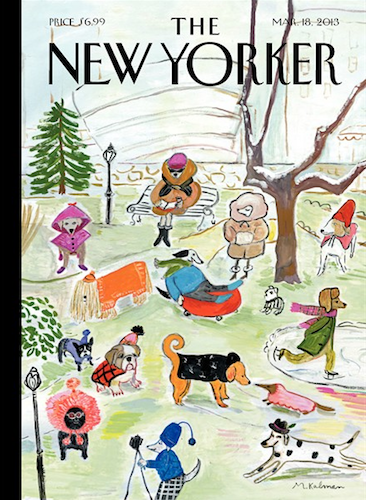
(Image credit: The New Yorker)
This week’s New Yorker cover features a rendering of Frank Lloyd Wright’s Guggenheim Museum, and I thought the occasion merited some meditation on what the museum means to us today. It’s an odd shaped building, and I can’t think of one that’s been built like it sense. Snøhetta’s Oslo Opera House, pictured below and opened in April 2008, is a great example of how contemporary architects are still designing buildings for the arts in brave new ways. (That fantastic structure mimics a Norwegian glacier melting into the sea, and many of its smart features work to invite all of Oslo, not just the operatic elite, to inhabit within and without.) But no structure for the arts built since 1960 has been as original as Frank Lloyd Wright’s Guggenheim Museum. Opened on 21 October 1959, the Guggenheim Museum is Frank Lloyd Wright’s last masterpiece. It was (more or less) commissioned in 1943, but the project took Wright 15 years and over 700 sketches to complete. Such revision is unusual for a Wright project, of course – most of his designs were completed in a matter of hours. (I suspect he was always thinking about his projects, and thus when the time came to get his ideas down on paper for clients there wasn’t much work to do.) What’s so unique about the Guggenheim Museum is that it’s a descending spiral. This design has two benefits: visitors can effortlessly enjoy the museum’s exhibit as they casually descend a ramp and, more importantly, the changing diameter of the spiral always allows for natural lighting at the art. Form follows function.

(Image credit: Wikipedia)
The New Yorker cover is interesting in that the Guggenheim Museum is not its subject, yet the building is featured prominently behind a scene from Central Park. That scene, let’s be honest, features a bunch of dogs dressed lamely according to breed. What are we to make of this montage? Was the Guggenheim placed in the background merely because everybody knows it sits prominently on New York’s Central Park? But anyone who knows this would also know that the stretch of Central Park in front of the Guggenheim isn’t fit for a dog fashion show – the museum’s right in front of Jacqueline Kennedy Onassis Reservoir. Of course, I suppose the ridiculousness of the dog show negates some expectation of reality. But then why the Guggenheim? Any number of buildings on Central Park West would have sufficed.

(Image credit: The New Yorker)
I suspect that perhaps the New Yorker cover is a subtle commentary on artsy pretention. Whatever you conclude about the cover will depend on what you think about certain fashions. I myself loved the dapper Dalmatian, and took to enjoying the ways in which each dog’s breed determined their wardrobe. The Pug is correctly dressed like one of the grandmothers from National Lampoon’s Christmas Vacation. But I can also see how someone not interested in the different ways people dress might find all of the dogs on the cover ridiculous. Just the same way that someone might find some of the Guggenheim’s notorious avant-garde art ridiculous. But I think that the take away here is that the museum is iconic. It just sits there in its spirals, and will last longer than whatever trendy business happens outside (or inside). By allowing form to follow function in such an extreme way, Frank Lloyd Wright’s last masterpiece clearly inspired architects as far away as Norway.



Recent comments
2 years 29 weeks ago
2 years 44 weeks ago
2 years 44 weeks ago
2 years 50 weeks ago
3 years 4 weeks ago
3 years 4 weeks ago
3 years 4 weeks ago
3 years 6 weeks ago
3 years 6 weeks ago
3 years 6 weeks ago